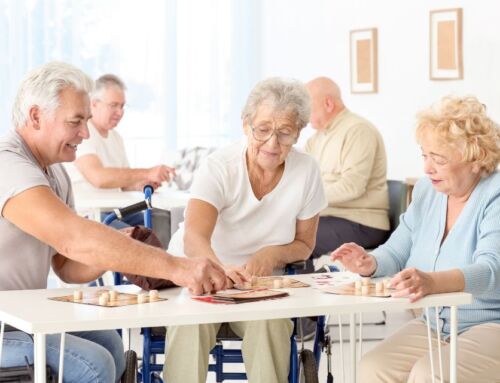Everything Seniors Need to Know About Assisted Living
Understanding exactly what Assisted Living means can be difficult. It’s common to hear people talk about how they plan to age in place, but few Americans understand what that actually means. Homes aren’t designed with the needs of elderly residents in mind, neighborhoods change, and many seniors who choose to age in place find themselves struggling with social isolation, difficulty keeping up with home maintenance, and increased risks of potentially dangerous falls, infections, and health problems.
Unfortunately, there’s a lot of misinformation out there regarding what other options are available. Many seniors and their loved ones assume that if they no longer feel safe living at home or need more help than family members and friends can provide, the only option is to move to a long-term care facility. For most seniors, assisted living provides a much better solution.
What Is Assisted Living?
Assisted living facilities are designed explicitly to accommodate seniors who want to maintain their independence without placing their health and safety at risk. They feature independent or shared apartments that offer all the comforts and amenities of home, but also offer easy access to things like nursing care, personal assistance, transportation, social activities, and more. There’s staff on-hand round-the-clock to help aging residents meet their changing needs in a safe and comfortable environment without giving up their privacy and independence.
Benefits of Assisted Living
Seniors have a few options when it comes to housing, but for those who are eligible, assisted living beats most common alternatives. Here’s why:
- No need for wasting time on home maintenance
- Plenty of privacy
- Ongoing independence
- Help with transportation
- Plenty of opportunities to socialize
- Easy access to assistive services
- Lower cost than nursing homes
- Higher quality of living
- Easy to adapt to changing needs
Although not all seniors are eligible for acceptance into assisted living communities, those who are eligible typically find that they have more free time to pursue their personal hobbies and passions, have an easier time making new friends, and feel just as comfortable in their new surroundings as they did at home. It may take a while to adjust, but for most, the many benefits of assisted living communities outweigh the minor inconvenience of adjusting to a new home and way of living.
How it Works
Assisted living communities are usually composed of between 25 and 120 individual rooms or apartments. Each resident typically maintains his or her own private space, although help with housekeeping tasks like cooking, cleaning, and laundry is often available. Some facilities also offer shared rooms or apartments for couples, friends, or residents who want to save money on rent.
All assisted living communities also feature communal spaces. These often include dining halls, entertainment rooms, small gyms, and other spaces designed to encourage peer-to-peer social interactions. Both individual apartments and communal spaces are designed to be mobility-friendly, so there’s no need for seniors who use assistive devices like walkers to worry about how they will get around.
Available Services
One of the many benefits of moving to an assisted living community is that it gives seniors access to all the services they’ll need to maintain an independent lifestyle on-site. Every facility is a little different, but all of them offer the following services:
- Nutritious meals
- Transportation to doctors’ appointments
- Help with bathing, dressing, and personal hygiene
- Medication management
- Comprehensive building security
Some communities also offer additional services. They may include skilled nursing, physical therapy, memory care, help with scheduling appointments, and more.
Meals are typically prepared by trained chefs and served in dining halls, although residents may choose to eat in their rooms or prepare their own food. Many apartments are equipped with kitchenettes or even full kitchens.
Social Activities
Most assisted living facilities allow residents to entertain guests, and some even allow them to keep pets like dogs and cats. Residents are also allowed to come and go as they please, so it’s perfectly fine to rent a room or an apartment at an assisted living facility but still go out to visit nearby friends and family members. Some communities even provide help with transportation to and from off-site social events, although they’re not typically free of charge unless the event was planned by the staff.
What’s really great about assisted living communities is that they also foster a sense of community among residents. Given that social isolation can be damaging to seniors’ mental, emotional, and physical health, that sense of community can be a literal life-saver.
For newcomers who are moving in from neighborhoods that used to feel vibrant and full of life but have become all but unrecognizable over the years, the improvements in social life afforded by assisted living will come as a breath of fresh air. Residents will be able to participate in organized activities, enjoy time with their peers, engage in their favorite hobbies with friends, or even learn new ones. Many communities even organize social outings and provide transportation free of cost.
Safety and Security
It’s common for seniors to become victims of crimes like burglary, identity theft, and others. Assisted living communities provide on-site security solutions to keep their residents safe, day and night. Since they take care of everything from property maintenance to arranging transportation and carefully vet all staff members prior to hiring them, there’s no need for residents to worry about who they are letting into their homes or who will be behind the wheel when they get rides to their appointments.
Security is not the only concern that disproportionately plagues seniors. Many older Americans are at increased risk of falls, which can be devastating, especially for those who choose to age in place alone. Assisted living facilities are designed with fall prevention in mind. They typically have grab bars in all bathrooms, elevators between floors, and call systems in place in individual rooms to allow seniors to request help immediately if something goes wrong.
Moving to an assisted living community can also improve seniors’ physical, mental, and emotional health. Staff members will be on-hand to help with things like medication management, and while most facilities do not provide round-the-clock skilled nursing care, they are well equipped to handle minor medical emergencies. Residents have less stress, more social support, and access to all the resources required to live a healthy, fulfilling life.


















